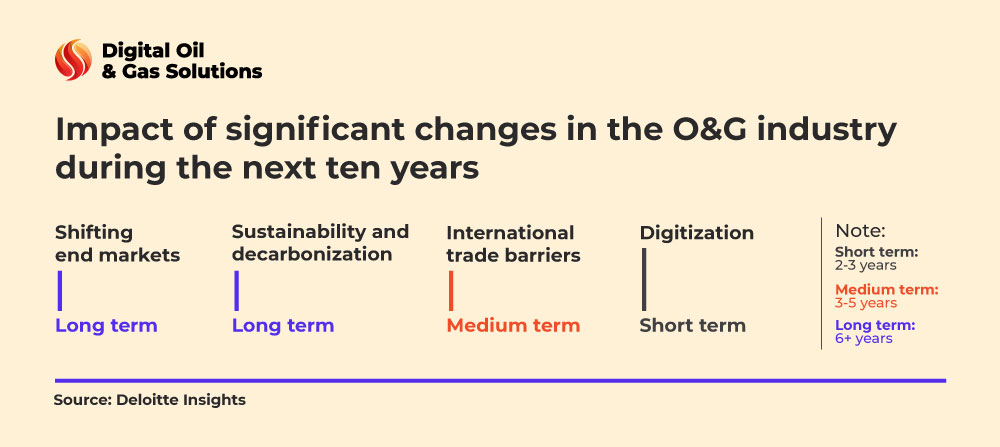Ubiquitous remote work and lower industrial demand for energy and materials caused by the pandemic have put business resilience in oil and gas on the agenda. With energy and industrial revenues declining by 54 and 25 percent respectively, the economic panorama over the energy sector is far from stable. As the industry suffers notable disruptions, the pandemic and consequent drop in oil prices have made it more vital than ever for oil companies to create an effective business resilience strategy.
What is business resilience, and how will it influence the future of the oil and gas industry?
Business resilience is an organization’s ability to adapt to an unfamiliar environment after or during any significant disturbance, enabling them to survive and thrive in increasingly unfavorable conditions. Today, technology is challenging the old assumption that any company could obtain resilience only at the cost of efficiency. The most progressive approaches offer innovative solutions for running scenarios, monitoring many suppliers’ network layers, accelerating response times, and even changing production economics. Proper technology guarantees to maintain revenue streams, increasing sustainability, and bringing organizations closer to their customers.
To better understand the future in oil and gas industry spheres, we will dive into some significant shifts and opportunities. By doing so, we will help industry leaders make the right decisions and build a solid foundation for business resilience.
All-out effort from leaders is vital in the foreseeable future
The pandemic has delivered the most significant and extensive value chain collision recently. However, it is only the latest in a range of disturbances, which inevitably exposes the weak spots within broader value chains. Therefore, the operation of a supply chain can be a source of vulnerability or resilience. A well-thought business resilience strategy depends on its effectiveness in monitoring risk, executing mitigation techniques, and implementing business continuity plans. Addressing major changes in advance can secure the future of oil and gas industry success.
With our extensive experience in the industry, we have examined four key oil and gas shifts that will determine the industry’s direction and challenge traditional O&G production methods.
1. Shifting end markets
Many companies will face lower consumer demand during the next few years, meaning that refinery utilization will decrease and revenue will be slower. Enterprises will need to navigate the hostile market conditions that indicate changing consumer preferences, investor expectations, and tightening regulations. However, companies can position their business for new challenges to avoid such circumstances.
2. Sustainability and decarbonization
The pressure governments and consumers face on decarbonization will increase as the signs of climate change are exposed and continue expanding. Recent surveys state that 58 percent of industry leaders believe that achieving a future with clean energy relies on the oil and gas sector. The production and use of energy will become a major influence in government policies, investment strategies, and consequently, consumer choices.
3. International trade barriers
Obstacles such as transportation costs, thin markets, restrictive contracts, noncompetitive pricing, risk, and government trade restraints are barriers that still have a significant impact on worldwide commerce. Opportunities for growth and exportation will continue to be restrained by international trade barriers.
4. Digitization
As technology becomes a vital asset, the need to create precise process control will force businesses to run complex analyses and collect a higher volume of data. This shift has been rapidly evolving and will continue to do so. Companies that want to stay ahead will have to adopt innovative technologies, turn data into actionable insights, and accelerate their digital transformations.
At Digital Oil & Gas Solutions, we offer diverse services, and we have partnered with many organizations to help them accelerate their digital transformation journeys. Contact us and find out how we can help secure your market share in the future of oil and gas industry risks.

Opportunities to protect the future of the oil and gas industry
The pandemic has accelerated a transformation that might have taken years to happen in a matter of months in the oil and gas industry. Stepping into the new energy future could be challenging and may require companies to make bold decisions. The following opportunities will help companies decide what direction to take and how to build business resilience in 2021:
- Calculated strategy
Devising an effective strategy that includes the diversification of product offerings will significantly help. To create valuable business opportunities, adding superior materials that are recyclable and low carbon will lower risks. For instance, consider modern technologies in the delivery industry, which is growing exponentially, and think of the way your company can promote new services or products for them. By looking at innovative fuel production and distribution, sustainability will be accomplished.
- Digital acceleration
Although digitalization is not new in the sector, embracing it is no longer an optional extra. With increased technology and software power, more companies have integrated a new approach to automate operations. Technology can deliver detailed customer data and influence market sensing, manage inventory, and predict demand. Consequently, businesses will become more proactive and better connected between operational and economic patterns. Our experience implementing automation for many oil and gas companies has proved that by accelerating digital transformation, expenses decrease while agility increments.
- Talent skills
The necessity to work from home during the pandemic highlighted the need for a more flexible and digital-ready workforce that is better connected. The demand for talent with digital and data science skills has grown due to the challenges being faced by the pandemic. Integrating training programs with digital technologies is a great opportunity to shape the skills of the workforce of the future. Simplifying processes and upskilling people will improve decision-making, health, safety, environmental risks, and reduce nonproductive time.
A successful business resilience strategy is impossible without cybersecurity
In the era of remote work and the massive use of online oil and gas business solutions for asset monitoring, management, and forecasting, we must admit that business continuity directly depends on cyber-resilience. So, when planning a safe future for your business, consider online security on a par with digitalization, upskilling, and sustainability. Below we will share the top five principles for you to deal with cyber challenges efficiently:
- Create a holistic cybersecurity governance framework that will cover not only operational technologies, software systems, and digital transformation techniques but also your company’s environment, health, and safety policy. By doing so, you will promote consistency across the ecosystem and facilitate interoperability within the enterprise.
- Drive security by design culture by introducing standards throughout the entire value chain, from oil and gas operations buildings to energy assets to IT systems.
- Act with full corporate responsibility for cyber business resilience in oil and gas and ensure that board and management members realize risks to the enterprise and the entire ecosystem. Review your internal practices and policies and shift a risk prevention and management approach if necessary.
- Promote all-around ecosystem collaboration to predict, monitor, and manage ecosystem-wide vulnerabilities. Support knowledge sharing and training sessions to bridge the gaps between your departments and teams. Create collective controls, plans, and approaches to digital risks to enhance your monitoring and response capabilities.
- Work on an organization-wide cyber business resilience strategy that will be shared and explained to all the ecosystem members. Listen to your colleagues and take time to test and improve it. It’s worth noting that an effective plan should cover not only your protection and readiness against growing attack surroundings but also recovery and prevention capabilities.
Mature cyber resilience is crucial in prudent care and diligence when doing business in the energy sector. By including security in your business resilience strategy, you can reduce risks, protect oil & gas future initiatives, and facilitate business automation techniques.
Decisive factors for success
As the industry encounters notable changes, how can companies ensure business continuity and effective crisis management? We’ve discussed the value of implementing well-calculated strategies, technology adoption, and upskilling talent, which will be critical to building business resilience. However, as organizations detect new risks, they need to decide on how to respond. Today many rely on complex processes that involve certain kinds of bureaucracy to make decisions, slowing their ability to act. Resilient companies not only resist perils but also emerge more potently. Below, we will go through some actions that you can take to gain the required abilities and finally answer the question of how to build business resilience:
- Reset the purpose of risk management. Instead of thinking about risk as a matter of prevention and mitigation, create value around it and incorporate it to a dynamic strategic enablement.
- Apply agile risk-management processes. Quick decision-making is essential across functional teams. Encourage the workforce to be part of the process by making risk management techniques, innovations, and business decisions.
- Control data and analytics. The dynamism of data can be used to extend the view of risk components, and by digitizing workflows, algorithms will help to detect errors better and get precise predictions.
- Increase risk talent for the future. The workforce needs to be enabled to understand the risk scenery. As they develop the required skills and expand their knowledge, they will be better prepared to respond quickly to disruptions.
- Encourage risk culture. Integrating risk into your daily business activities and outcomes will make your company familiar and unafraid of risk. Building a risk culture will bolster the confidence and ability to face challenges.
Admittedly, digital technologies and tools transform oil and gas from analog to remotely managed, IoT-driven, and smart, enabling decision-making at lightning speed. However, it all comes at a cost, and when leaders decide to digitize processes, they immediately expose organizations to various risks. So, executives should turn business resilience in oil and gas into a core competency and place it at the center of their future business resilience strategy and operating model.
Organizations can learn from the many risks they currently face and benefit from disruptions by changing their approach. Up to now, risk management was not usually considered a source of efficacy, strength, or advantage. But today, more than ever, effective and dynamic risk management is critical to building business resilience and thriving in adverse times.






